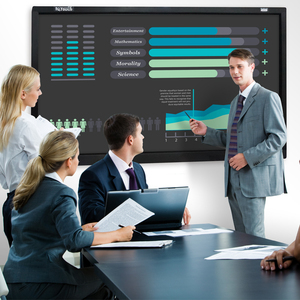(64664 products available)






























































































































































































































A large touch screen is an electronic device with a wide display designed to respond to human touch. Here, ""large"" means having a screen size of at least 20 inches, while touch sensitivity can be of various types, including resistive and capacitive. Users can interact with the interface by tapping, pinching, swiping, and rotating. Large touch screens are available in different variants depending on application and usage. Evidence of this can be seen in the growing number of large touch screen manufacturers and suppliers worldwide. In 2022, the global large touch screen market was estimated to be worth $14 million. Touch screen displays are used in public areas where information needs to be provided quickly and conveniently, such as transportation, hospitality, stadiums, healthcare, education, and retail.
Enhanced Visual Experience:
Touch screens with large screens provide stunning visuals, whether for entertainment, presentations, or day-to-day chores. Large screen sizes are compelling and immersive, while high resolutions (HD, Full HD, or even 4K) produce clear, crisp images.
Intuitive Interaction:
Large touch screens combine direct touch control with simple and user-friendly navigation experiences. Screen scrolling, object dragging, and zooming in or out with gestures enable natural and friendly operations. This is especially useful for people who may not be very computer savvy.
Collaborative Features:
Multitouch functionality allows more than one user to touch the screen simultaneously. Sharing information or working on projects in real time with colleagues or other users fosters collaborative environments in classrooms, conferences, and workplaces.
High Responsiveness:
Using capacitive or resistive touch technology, large touch screens respond to user inputs smoothly and quickly. Precise tracking and accurate registration of touches, taps, and gestures reduce latency and ensure a responsive experience. This means users can expect their actions on the screen to be executed without delay.
Versatility and Compatibility:
Large touch screens are compatible with various applications and devices, making them multipurpose tools. Whether connecting laptops for presentations, using interactive whiteboards in education, or serving as centerpiece displays for digital signage in retail, they adapt to different settings. Moreover, many support various operating systems, like Android, iOS, Windows, and Linux, ensuring broad usability.
Mounting Options:
Various mounting options are available for large touch screens to suit different preferences and settings. These include wall mounting, stand-alone kiosks, tables and surfaces for interactivity, flexible arms for adjusting position and angle, or modal mounts for switching between landscape and portrait orientations. The diverse options allow optimized integration in individual situations.
Large touch screen displays can be used wherever a user-friendly display of information is needed. They have many applications.
Business
In the office, large interactive touchscreens can replace paper-based meeting agendas. They can also show dynamic digital signage to direct visitors. In conference rooms, large touch screens enable collaborative brainstorming. Teams can create, edit, and present ideas using interactive diagrams and charts.
Restaurants and Retail
Restaurants and stores use large touch screens for menus and product catalogs. Customers can browse with ease. Order placing and purchases become efficient. Feedback surveys allow businesses to quickly respond to customer preferences.
Transportation Hubs
Airports, bus and train stations use large touch displays for wayfinding maps. Schedules, routes and platform changes are readily accessible on large interactive boards. Real-time updates reduce traveler confusion.
Healthcare Facilities
Hospitals and clinics use large touch screens in waiting areas. Patients use them to check-in and view their status. Interactive health education programs promote wellness. Staff can quickly access medical records on large, responsive monitors.
Education
Schools and universities now have digital smartboards in classrooms. Teachers use large touch screens for interactive lessons. Students can work together on problem-solving games and group projects. At study centers, tutorial apps give extra academic help.
Public Information Centers
Tourist attractions and museums have large touch exhibits. Digital kiosks allow visitors to learn with interactive content. Historical displays and art pieces can be explored through multimedia presentations. Wayfinding maps help guests navigate the site efficiently.
When picking interfaces for huge contact screens, undertakings ought to painstakingly assess their necessities and the accessible choices to distinguish the best arrangement. A few standards can be considered while choosing the best huge touch screen for specific prerequisites:
Q: How large is a large touch screen?
A: A large touch screen can be considered anything above 10 inches in size. Screens above this size are deemed large because they offer a good resolution or responsiveness and provide a comfortable viewing experience.
Q: What are the benefits of large touch screens?
A: Large touch screens have many benefits, such as better visibility, user engagement, and interactive experiences. They are much easier to see from longer distances, which makes them ideal for presentations, meetings, and classrooms. Touch screens also allow multiple people to use them simultaneously, which increases collaboration and creative input. The larger size makes the screen more attractive, which enhances its interactivity and keeps the viewers' attention.
Q: What industries use large touch screens?
A: Large touch screens can be found in many settings including but not limited to retail, hospitality, education, healthcare, entertainment, and transportation industries. They are mainly used in command centers, control applications, self-service kiosks, digital signage, point-of-sale terminals, interactive displays, and menu boards.
Q: What features should one look for in large touch screens?
A: One should look for large touch screens with touch technology, multi-touch functionality, durable construction, and resolution. Comparing different screen technologies can help one choose a more responsive touch screen. The resolution and display technology choices should provide clear images and vibrant colors. *Large screens also require better support and protection against daily use; hence, the screens should be made of durable and robust materials.*